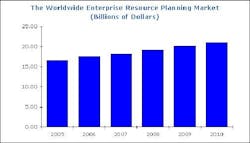The worldwide market for enterprise resource planning (ERP) systems is expected to grow at a 4.8 compound annual rate, rising from $16.7 billion in 2005 to more than $21 billion in 2010, according to a new study from ARC Advisory Group Inc., Dedham, Mass.
The study focuses on ERP software license revenues, because that is a strong barometer on how the market is really going, says ARC Senior Analyst Steve Clouther, the principal author of the study—titled “Enterprise Resource Planning Worldwide Outlook.” Over the years, service revenues, especially maintenance, far outperform license revenues, as vendors build on an installed base that continues to grow.
Chasing SAP
Many industry vendors are executing aggressive acquisition strategies in an attempt to gain market share on SAP AG, Walldorf, Germany, which holds the dominant ERP market position. But these vendors face many challenges in the post-acquisition phase, Clouther says, such as defining a clear, go-to-market strategy for integrating the various products and the installed base.
The ARC study points out that China is a large emerging market for ERP systems, given its rising preeminence in global manufacturing. And while ERP had its genesis in manufacturing, growth in the worldwide market is also being driven by users from a wide range of other industry sectors, who are taking advantage of the benefits offered by ERP solutions, says the study.
The study looks at other enterprise applications, including customer relationship management (CRM), enterprise asset management (EAM), product lifecycle management (PLM) supply chain management (SCM) and supplier relationship management (SRM)—as provided by the vendors classified as “ERP.”
Necessary evil
There has always been a need for integrated solutions, especially when talking about an integrated enterprise from the plant floor up to the executive offices. With the continued demand on acquisitions, along with the programs to address the small-to-medium size business market, systems integration is a necessary evil between ERP and other enterprise solutions, ARC says. Integration has been difficult, but service-oriented architecture (SOA) provides value to the enterprise by freeing key pieces of business functionality from individual systems, and making them available for integration with other applications.

